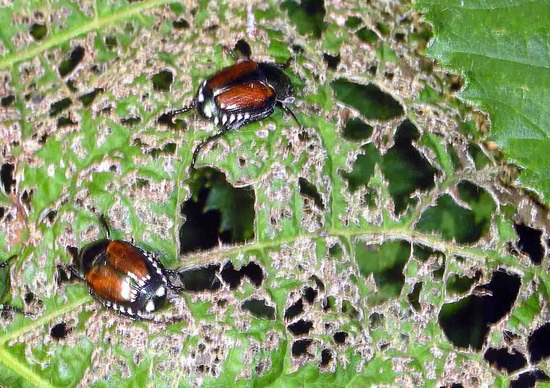3 Ways to Prevent Japanese Beetle Damage this Summer
Japenese beetles have long plagued Kansas City landscapes right as they start to look good. The pest emerges in the heart of summer to devour your favorite plants, shrubs and trees as they feast on the delicate leaf tissues.
You’ve seen their damage before, but you might have realized what it was from. You’ll recognize the Japanese Beetle on your property by the lacy effect leaves and plant tissues will take after being fed on by the beetles.

ABOUT THE BEETLES
Both adult and the grub stage of Japanese beetles cause serious damage to many landscape plants (more than 320 species) and turf grasses. The adult beetles skeletonize the leaves by chewing between the veins of the leaf tissues, devour the flowers (roses) and fruits (raspberries), and ultimately weaken the plant. Roses, birch, linden, grapes, raspberries, Norway maples, beans, apples, plum, crabapples, elms, beech, asparagus and rhubarb are some of its favorite delicacies.
Huge swarms of these beetles emerge with peak activity for six to eight weeks. Adult beetles are active during the daytime and can fly an average of 1 to 2 miles. The female beetle lays eggs on the ground, which hatch in about two weeks into white grubs that damages turf grass roots.
HOW WE PREVENT & TREAT FOR JAPANESE BEETLES
True North Outdoor Business Unit Leader Erik Stewart says the three keys to preventing them are to apply the right product at the right time for the right species. Stewart says this principle applies to any pest, whether thats weeds or fungus or disease. For the Japanese Beetle in particular, we both prevent and treat by applying a cocktail of two treatments that address all the life cycle stages of the Japanese Beetles.
Step 1: We utilize a contact insecticide that kills beetles as soon as it touches them. As we spray it on trees that are a habitat to that beetle, they’ll start dying and falling off of the tree.
Step 2: We then apply a substance that has a residual effect. It is bound up in the tree for 30 days. This product will kill beetles as they feed on the plant material.
For our Kansas City clients, Linden trees are especially susceptible to these pests, and we take special care to spray these trees once in early June and once 1 month after when the beetles are fully in flight with our two-step process.
It’s not too late to protect your trees from the infestation that will likely occur this July – August. Don’t let this nasty pest have its way with your landscape! Reach out to us today to ensure your trees and plants are protected.
